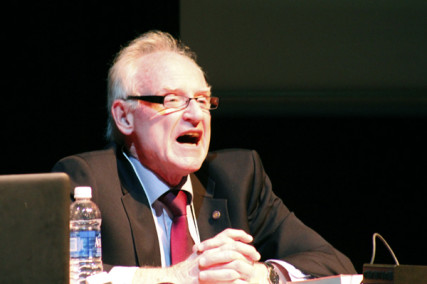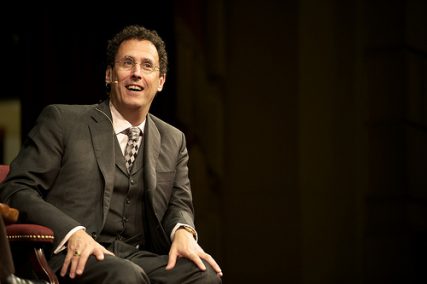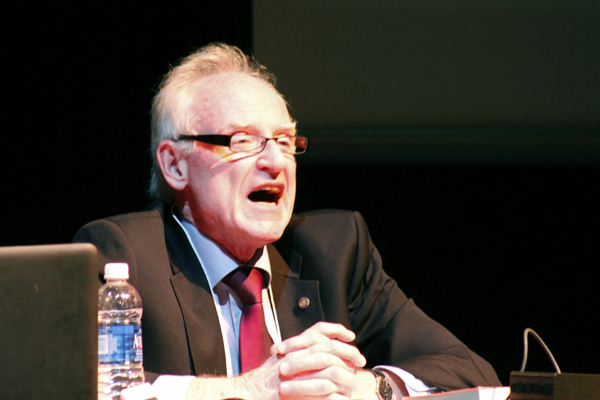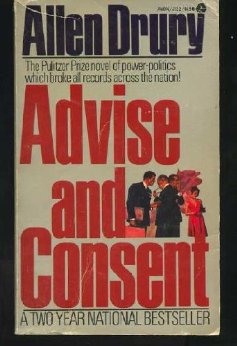(RNS) Jerry Argetsinger never felt a twinge of tension between being gay and being Mormon.

Jerry Argetsinger gives a talk at the University of Missouri about the increasing number of gay Mormon characters and themes in theater. He is also the editor of a new anthology of short works that deal with homosexuality and Mormonism. RNS photo by Kellie Kotraba/Columbia FAVS
Nobody talked about homosexuality in his Oregon congregation of the Church of Jesus Christ of Latter-day Saints when he was growing up in the 1960s. Nobody asked him about his attractions. Nobody made cruel or even not-so-subtle comments about him. Nobody made him feel guilty.
It came as a bit of a shock, then, when Argetsinger was beginning his sophomore year at LDS church-owned Brigham Young University in 1965 and heard university President Ernest L. Wilkinson say that the school didn’t want any gays on campus.
Fortunately, the young theater major left a month later for his two-year LDS mission in Denmark, which, Argetsinger said, was “a great experience.”
When he told a visiting apostle, Howard W. Hunter (who became LDS church president in 1994 until his death in 1995), that he was gay, Hunter assured the young missionary that he was doing well and urged him to “just keep your feelings to yourself.”
That set the pattern of church response for the next five decades, Argetsinger said: private acceptance from various Mormon leaders but no public acknowledgment.
That may be changing.
Last week, Argetsinger unveiled “Latter-Gay Saints: An Anthology of Gay Mormon Fiction,” which he edited with Jeff Laver of Salt Lake City and Johnny Townsend of Seattle.
The book features 25 short stories and four plays, each work exploring how it felt to be gay in families, or at church, or on missions.
“None of these stories purport to represent any ‘official position’ of The Church of Jesus Christ of Latter-day Saints,” Argetsinger writes in the book’s introduction. “But they do represent our lives, our hopes, our aspirations.”
The 67-year-old LDS writer and director, who lives in Rochester, N.Y., near Mormonism’s birthplace, is thrilled by the sequence of events that led to the book’s publishing.

Tony Kushner discusses Angels in America at 20, during a Commonwealth Club program in San Francisco’s Herbst Theatre on Nov 6. 2010.
It is, for example, the 20th anniversary of “Angels in America,” Tony Kushner’s Pulitzer Prize-winning play that showcased one of the first gay Mormon characters.
The anthology also comes at a time when the LDS church seems more open to discussing the real-life experience of its gay members.
The same December 2012 day he began his final work on the book, the LDS church announced the creation of a website, mormonsandgays.org, which has a softer tone about same-sex attraction.
“We are at the dawn of acceptance of gays in the church,” Argestsinger said. “The church is saying, ‘We want your stories,’ and pieces are falling into place.”
He believes his book will contribute to the new openness.
“I believe this (book) is part of my (religious) calling,” he said. “Clearly, the Lord took this in his hands and made it happen.”
It’s been a long time coming.
A natural partnership
When Argetsinger returned to BYU after his LDS mission, he threw himself into the theater department. That’s where he met his future wife, Gail, who had a way with fashion and fabrics.
He didn’t tell her about his sexuality before they married, but both felt a strong — and separate — spiritual confirmation that they should wed.
“When I found out, there was a question whether or not to stay with the marriage,” Gail Argetsinger said. “I felt overpoweringly moved to stay. Ours is a partnership beyond the movie image of a marriage.”
From 1990 to 1997, he directed the faith’s “Hill Cumorah Pageant,” a giant, costumed spectacle, which re-enacts scenes from Mormon history and scripture. Gail Argetsinger was the pageant’s costume designer from 1978 to 1997.
The couple’s two sons are fully accepting of their dad (even have fun teasing him about his sexuality), their mother said.
At the beginning, there were tough times and a “steep learning curve,” Jerry Argetsinger acknowledged, but “we’ve been married 43 years. We love each other and it worked.”
Both are quick to say that marriage to a woman is not a pattern they recommend for other Mormon gays, nor is it one that the LDS church now recommends as it once did.
Only 4 percent of mixed-orientation marriages survive, Argetsinger said. “I would never tell a gay man to marry a woman, unless the (Holy) Spirit confirmed it as it did for us — and I don’t mean a bishop.”
Part of his self-confidence, he said, comes from living and working in upstate New York, where he teaches in the cultural and creative studies department of Rochester Institute of Technology’s National Technical Institute for the Deaf.
At church, he serves on his LDS stake’s “high council,” a group of male leaders who help supervise several congregations.
Argetsinger has been open about his sexuality with Mormon leaders, he said, and they have been supportive of him, even sending gay members and their parents to him for counsel and advice. “Latter-Gay Saints” is dedicated to three LDS stake presidents and a bishop.
“We have had 16 teen boys in Rochester who were gay and whose fathers were church leaders — a patriarch, a stake president, temple president, mission president and several bishops,” Argetsinger said. “When you are dealing with it at home, it changes everything at church.”
And for some, the best way to explore their feelings is through fiction.
The stories come pouring out
Argetsinger began researching Mormon gay literature about five years ago.
Before he knew it, he had found some 200 stories and plays that fit the theme, many of which had been written or produced in the past decade.
The first gay Mormon character Argetsinger could find was Sen. Brigham Anderson in Allen Drury’s novel “Advise and Consent.”
“The topic was so taboo in 1959 that even though the Mormon senator from Utah’s homosexual affair was the pivotal event of the entire novel, neither the word ‘homosexual’ nor any of its counterparts appeared in the book,” Argetsinger writes. “The critical event of the story was exclusively implied.”
Drury needed a senator “who was squeaky clean, intelligent, popular and above all respected,” he writes, and the Mormon figure seemed to provide that.
Kushner, on the other hand, got a lot about Mormonism right in his depiction of closeted gay Mormon Joe Pitt in “Angels in America.”
Drury and Kushner won Pulitzers for their efforts, but neither was or had ever been a member of the LDS church.
The first gay LDS writer, Argetsinger discovered, was Richard Fullmer, a young gay man who left Utah in the mid-1960s for the streets of San Francisco. He took up the pen name “Dirk Vanden.”
“He created literary stories which included central Mormon characters,” Argetsinger writes in the introduction, and then, without his knowledge, publishers inserted scenes of “hot gay sex” for more sales.
Today, Vanden “is hailed as one of the pioneers of gay fiction,” the introduction said, and his short story “Gay Messiah” is included in this volume.
Argetsinger said, the book helps move the question for homosexual Latter-day Saints from “Am I gay?” to “What kind of gay Mormon am I going to be?”
Each person, he said, must decide alone — or with divine help.
Argetsinger certainly has.
(Peggy Fletcher Stack writes for The Salt Lake Tribune.)
YS/AMB END STACK






